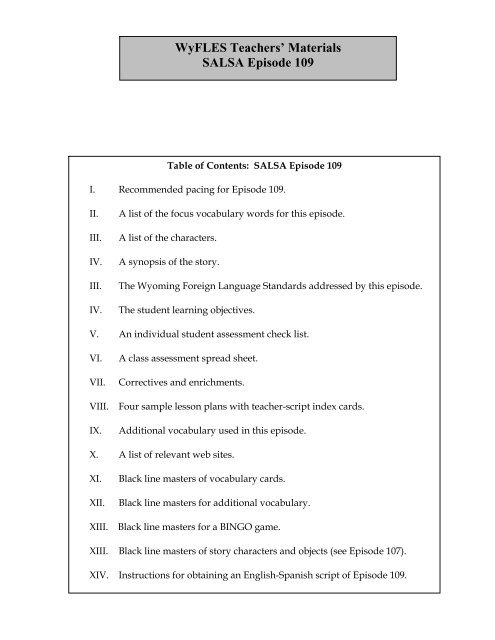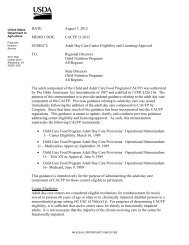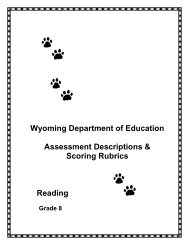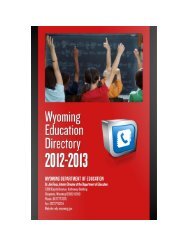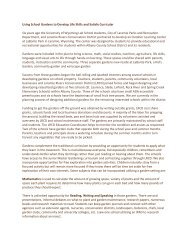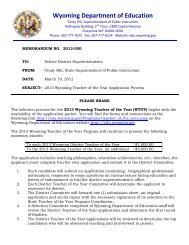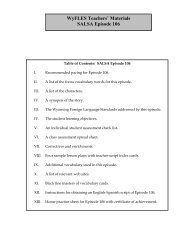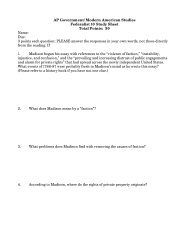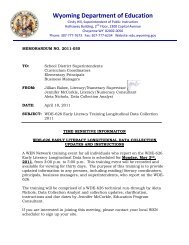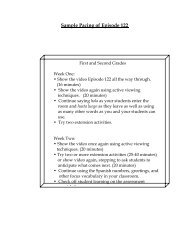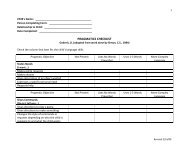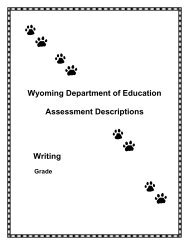WyFLES Teachers' Materials SALSA Episode 109
WyFLES Teachers' Materials SALSA Episode 109
WyFLES Teachers' Materials SALSA Episode 109
You also want an ePaper? Increase the reach of your titles
YUMPU automatically turns print PDFs into web optimized ePapers that Google loves.
<strong>WyFLES</strong> Teachers’ <strong>Materials</strong><br />
<strong>SALSA</strong> <strong>Episode</strong> <strong>109</strong><br />
Table of Contents: <strong>SALSA</strong> <strong>Episode</strong> <strong>109</strong><br />
I. Recommended pacing for <strong>Episode</strong> <strong>109</strong>.<br />
II. A list of the focus vocabulary words for this episode.<br />
III. A list of the characters.<br />
IV. A synopsis of the story.<br />
III. The Wyoming Foreign Language Standards addressed by this episode.<br />
IV. The student learning objectives.<br />
V. An individual student assessment check list.<br />
VI. A class assessment spread sheet.<br />
VII. Correctives and enrichments.<br />
VIII. Four sample lesson plans with teacher-script index cards.<br />
IX. Additional vocabulary used in this episode.<br />
X. A list of relevant web sites.<br />
XI. Black line masters of vocabulary cards.<br />
XII. Black line masters for additional vocabulary.<br />
XIII. Black line masters for a BINGO game.<br />
XIII. Black line masters of story characters and objects (see <strong>Episode</strong> 107).<br />
XIV. Instructions for obtaining an English-Spanish script of <strong>Episode</strong> <strong>109</strong>.
Sample Pacing of <strong>Episode</strong> <strong>109</strong><br />
First and Second Grades<br />
Week One:<br />
• Show the video <strong>Episode</strong> <strong>109</strong> all the way through.<br />
(16 minutes)<br />
• Show the video again using active viewing<br />
techniques. (20 minutes)<br />
• Continue saying hola as your students enter the<br />
room and hasta luego as they leave as well as using<br />
as many other words as you and your students can<br />
use.<br />
• Try two extension activities.<br />
Week Two:<br />
• Show the video once again using active viewing<br />
techniques. (20 minutes)<br />
• Try two or more extension activities (25-40 minutes)<br />
or show video again, stopping to ask students to<br />
anticipate what comes next. (20 minutes)<br />
• Continue using the Spanish numbers, greetings, and<br />
other focus vocabulary in your classroom.<br />
• Check off student learning on the assessment<br />
id d
Unit Theme: Caperucita<br />
Roja<br />
Focus Vocabulary:<br />
• Los manos (The hands)<br />
• Por favor (Please)<br />
• Gracias (Thank you)<br />
• Si (Yes)<br />
• No (No)<br />
Characters/Personajes:<br />
• Perro (Dog)<br />
• Caperucita Roja<br />
• Abuela (Grandmother,<br />
played by Mamá Osa)<br />
• Lobo (Wolf)<br />
• Armadillo<br />
• Papá Oso<br />
• Policía (Policeman)<br />
•Doctor<br />
Synopsis<br />
Still determined to get<br />
some goodies, the wolf<br />
returns disguised as an<br />
old man. Even though<br />
they recognize him,<br />
Caperucita and Abuela<br />
take pity on him and let<br />
him in to teach him<br />
some manners. Finally<br />
allowed to eat, the wolf<br />
stuffs himself and makes<br />
himself sick. He is<br />
carried away on a<br />
stretcher.<br />
Wyoming Standards:<br />
1. Communication:<br />
<strong>SALSA</strong> <strong>Episode</strong> <strong>109</strong>- Page 1<br />
Essential Activities:<br />
1) Watch the <strong>SALSA</strong> series guide for <strong>Episode</strong> <strong>109</strong>. Practice<br />
the focus words in preparation for introducing the episode<br />
to your students.<br />
2) Show the <strong>SALSA</strong> video of <strong>Episode</strong> <strong>109</strong> to your class at least<br />
twice each week. (See the Teacher’s Manual for active viewing ideas<br />
to involve your students as they watch it the second time!) You may<br />
wish to break it up into segments, or show it in its entirety.<br />
(16 minutes) Recommended pacing: three weeks per episode in<br />
kindergarten; two weeks per episode in first and second grades.<br />
(See scope and sequence in the Teachers’ Manual.)<br />
Continue greeting your students with ¡Hola! each time they enter your<br />
classroom and saying goodbye with hasta luego. Add as many other<br />
Spanish words and expressions as you can to your regular activities.<br />
Ideas for Expansion Activities:<br />
Sample Lesson for Day 1: (Estimated time: 25 minutes)<br />
The “index-card” script follows this section.<br />
1. With a hand puppet review the dialogue from previous episodes:<br />
T: Buenos días, (puppet’s name). Good morning, ______.<br />
(or Buenas tardes, as appropriate.) Good afternoon, .<br />
P: Buenos días, Señor/Señora/Señorita _________.<br />
Good morning, Mr./Mrs./Miss .<br />
T: ¿ Cómo estás tú? How are you?<br />
P: Muy bien, gracias.¿Y usted? Fine, thank you. And you?<br />
T: Muy bien, gracias. Fine, thank you.<br />
2. Review the following words with the class by first pointing at images<br />
and then to your own face: los ojos (eyes), los dientes (teeth), la nariz<br />
(nose), la cabeza (head), las orejas (ears), and la boca (mouth).<br />
Introduce the word las manos (hands). Say and repeat the words each<br />
time you show the image or point to your face or hands. Continue until<br />
the students mimic your actions.<br />
Notes:
Wyoming Standards:<br />
2. Culture––<br />
Students develop cultural<br />
understanding and<br />
demonstrate practices<br />
appropriate to the<br />
culture(s) in which the<br />
language is used.<br />
Objectives:<br />
Students will be able to:<br />
1. demonstrate verbally<br />
or non-verbally<br />
comprehension of:<br />
• Las manos<br />
• La cabeza<br />
• Los ojos<br />
• Las orejas<br />
• La boca<br />
• La nariz<br />
• Los dientes<br />
• Gracias<br />
• Por favor<br />
2. indicate verbally or<br />
non-verbally compre-<br />
hension and cultural<br />
awareness of:<br />
• Spanish words of<br />
courtesy (Por favor<br />
and gracias)<br />
Correctives and<br />
Enrichments: Please<br />
see the expansion<br />
activities provided with<br />
this episode.<br />
Assessment<br />
Observe the students for<br />
verbal or non-verbal<br />
indications of<br />
comprehension.<br />
(See assessments<br />
provided.)<br />
<strong>SALSA</strong> <strong>Episode</strong> <strong>109</strong> - pg. 2<br />
3. Give the following TPR commands with the images of the body parts:<br />
• Muéstrame las manos or Show me las manos.<br />
• Toca las manos or Touch las manos.<br />
• Toma las manos. or Take las manos.<br />
4. Ask who has the object: ¿Quién tiene las manos? (Who has the<br />
hands?) If the children don’t understand the question ask the following<br />
question: María tiene las manos ¿sí o no? (María has the hands, yes<br />
or no?)<br />
5. Continue with the following TPR command: Pasa las manos a Ana. or<br />
Pass las manos to Ana.<br />
Repeat this procedure with the rest of the body parts involving as many<br />
students as possible.<br />
6. Collect the images by saying Ana dame las manos. Muy bien,<br />
gracias. (Ana, give me the hands. Thank you.)<br />
<strong>Materials</strong> Needed:<br />
• The hand puppet (or other object) that you used in <strong>Episode</strong>s 107 and 108 to practice a dialogue for<br />
students.<br />
• Blackline masters (or other images or objects) representing the parts of the head and for the hands.<br />
(La cabeza, los ojos, los dientes, los orejas, la boca, las manos) In this case, you will need one<br />
image for each of these body parts.)<br />
Suggested web site:<br />
Check the official <strong>SALSA</strong> web site for an activity for this episode. The address is<br />
http://www.gpb.org/peachstar/salsa<br />
Vocabulary:<br />
Nouns<br />
Mis ojos (My eyes)<br />
Mis orejas (My ears)<br />
Mis dientes (My teeth)<br />
Mis pies (My feet))<br />
Mi cabeza (My head)<br />
Mi barriga<br />
(My stomach)<br />
Adjectives<br />
Note: the adjectives<br />
sucio (dirty) and<br />
limpio (clean) follow<br />
the regular pattern of<br />
Spanish adjectives.<br />
Sucio Dirty-masc.sing.<br />
Ex. Mi pie sucio<br />
My dirty foot<br />
Sucios Dirty-mas.plur.<br />
Ex. Mis pies sucios<br />
My dirty feet<br />
Sucia Dirty-fem.sing.<br />
Ex. Mi mano sucia<br />
My dirty hand<br />
Sucias Dirty-fem.plur.<br />
Ex. Mis manos sucias<br />
My dirty hands<br />
Limpio/limpios (clean)<br />
Masc.sing.plural<br />
Limpia/limpias<br />
Fem.sing.plurial<br />
Expressions<br />
Perdón. Pardon me.<br />
Ahora. Now.<br />
¡Rápido! Hurry!
Teacher Script Designed to be Pasted on a 5” X 8” Index Card<br />
THE TEACHER SAYS AND (DOES)<br />
<strong>Episode</strong> <strong>109</strong>: Lesson 4, Buenos modales<br />
Warm-up Dialogue (Model with a puppet)<br />
T: Buenos días, (puppet’s name). (or Buenas tardes, as appropriate.)<br />
P: Buenos días, Señor/Señora/Señorita ___________.<br />
T: ¿Cómo estás tú?<br />
P: Muy bien, gracias. ¿Y usted?<br />
T: Muy bien, gracias.<br />
Sing Buenos Días to the tune of Brother John<br />
Buenos días. Buenos días.<br />
¿Cómo estás? ¿Cómo estás?<br />
Muy bien, gracias. Muy bien, gracias.<br />
¿Y usted? ¿Y usted?
Teacher Script Designed to be Pasted on a 5” X 8” Index Card<br />
THE TEACHER SAYS AND (DOES)<br />
* a word in [ ] indicates you may choose to say the word or not say the word. An<br />
underlined word means that it could change to another noun.<br />
<strong>Episode</strong> <strong>109</strong>: Lesson 1, Buenos modales<br />
See card with warm-up dialogue for this episode.<br />
Review los ojos (eyes), los dientes (teeth), la nariz (nose), la cabeza (head), las orejas (ears), la<br />
boca (mouth) by pointing to images and then pointing to your own face and repeating the words.<br />
Introduce the word las manos (hands). Continue until the students mimic your actions.<br />
Give the following TPR commands:<br />
[Muéstrame] or Show Me las manos (los dientes, la nariz, la cabeza, las orejas,<br />
la boca). Point to your eyes (hands, teeth, nose, head, ears or mouth) as you say this.<br />
Toma las manos. Or Take las manos. Repeat with the other body parts, distributing<br />
the images around the room with different students..<br />
María tiene las manos ¿sí o no? Or Maria has las manos ¿sí o no? Ask yes/no<br />
questions to review which student has which image.<br />
¿Quién tiene las manos? Or Who has las manos? Repeat the question with other<br />
children until all the images have been mentioned.<br />
Páslea las manos a Ana. Or Pass las manos a Ana. Continue these commands,<br />
involving as many children as possible.<br />
Ana dame las manos. Or Ana, give me las manos. Muy bien, gracias. Collect the<br />
images at the end of the lesson.<br />
¡ Magnífico! Hasta luego, niños.
Objectives for day 2:<br />
Student will indicate<br />
comprehension of Spanish<br />
words by:<br />
• pointing to and<br />
manipulating objects of<br />
different colors:<br />
rojo/a<br />
amarillo/a<br />
azul<br />
verde<br />
morado/a<br />
anaranjado/a<br />
• doing simple<br />
addition problems using<br />
Spanish numbers.<br />
Connections to other<br />
subject areas:<br />
• Math- patterns<br />
• Math- addition<br />
<strong>Materials</strong> needed:<br />
• Differently colored<br />
flowers (see black line<br />
masters)<br />
Assessment:<br />
Watch and listen as<br />
students use the vocab,<br />
repeat after you in<br />
either-or questions, or<br />
indicate non-verbally<br />
their comprehension.<br />
(See assessment for <strong>109</strong>)<br />
<strong>SALSA</strong> <strong>Episode</strong> <strong>109</strong> - Page 3<br />
Sample Lesson for Day 2: (Estimated time: 25 minutes)<br />
As in the sample lesson for Day 1, an “index-card” script is<br />
included with the teacher materials for this episode.<br />
Photocopy several copies of different colored flowers. Use the flowers<br />
to create patterns. Point to each flower, saying what color of flower it is:<br />
una flor roja, una flor amarilla, una flor azul; una flor roja, una flor<br />
amarilla, una flor azul, etc.. Continue until the students are repeating<br />
with you.<br />
2. Let the students create their own patterns with the flowers.<br />
3. Put the different colored flowers on the board with magnets or tape. Ask<br />
different students to come up, point to a color and say what color it is.<br />
4. Put bunches of flowers on the board and ask the students to count the<br />
flowers with you. Say, Hay cinco flores azules. (There are five blue<br />
flowers.) Hay seis flores amarillas. (There are six yellow flowers).<br />
Finally, count all of the flowers with the students. Hay once flores.<br />
(There are eleven flowers.) See hint at right for pronunciation.<br />
5. Change the colors and numbers of the flowers and continue counting<br />
and practicing the phrase: Hay siete flores rojas.<br />
6. When the students are comfortable counting in Spanish, challenge them<br />
with addition. Dos y dos son cuatro. (Two and two are four) or Dos más<br />
dos son cuatro. (Two plus two is four.)<br />
If you are working on math patterns in your classroom or if addition is a major<br />
goal for your students, you may want to expand this activity to other objects in<br />
the vocabulary.<br />
(If you want to do subtraction, you can use the following<br />
pattern sentence: Seis menos cuatro son dos. (Six minus four is two.)<br />
Notes:<br />
Pronunciation Hint:<br />
Hay (there is/ are) is<br />
pronounced exactly<br />
like ¡Ay!¡Ay!¡Ay!<br />
since the “H” is silent.<br />
Math Expressions:<br />
Más (plus, more)<br />
Más que (more than)<br />
Uno más uno son dos.<br />
(One plus one is two)<br />
Menos (minus/ less)<br />
Menos que (less than)<br />
Cuatro menos uno son<br />
tres. (Four minus one<br />
is/are three.)
Teacher Script Designed to be Pasted on a 5” X 8” Index Card<br />
THE TEACHER SAYS AND (DOES)<br />
<strong>Episode</strong> <strong>109</strong>: Lesson 2, Buenos modales<br />
See card with warm-up dialogue for this episode.<br />
Create patterns with large colored flowers and have the students say the patterns<br />
aloud. (Colors: Roja, amarilla, verde, azul, morada (purple), anaranjada(orange)) Example:<br />
una flor roja, una flor amarilla, una flor azul, una flor roja, una flor amarilla,<br />
una flor azul …….<br />
Let the students create their own patterns with the flowers.<br />
Ask different students to come up, point to a flower and say the color.<br />
[Hay] cinco flores azules. Put one bunch of the same color of flower on the board<br />
and count them with the students. Add another bunch of a different color and<br />
count with the class. (Fem. Plural for flores: rojas, amarillas, azules, verdes,<br />
moradas, anaranjadas)<br />
[Hay] once flores. Or There are once flores. Count all the flowers together.<br />
Continue changing colors and counting flowers.<br />
Dos y dos son cuatro. or Tres más uno son cuatro. Practice adding using the<br />
flowers to create your number sentences.<br />
¡Perfecto, niños! Hasta luego.
Objectives for day 3:<br />
Student will indicate<br />
comprehension of Spanish<br />
words by:<br />
• indicating either<br />
verbally or non-verbally<br />
comprehension of the<br />
Spanish words:<br />
ˆ las manos<br />
la nariz<br />
los ojos<br />
los dientes<br />
la cabeza<br />
las orejas<br />
Connections to other<br />
subject areas:<br />
• Literacy<br />
<strong>Materials</strong> needed:<br />
• the images of the six<br />
vocabulary words. (see<br />
blackline masters)<br />
Assessment<br />
Observe the students for<br />
verbal or non-verbal<br />
indications of<br />
comprehension.<br />
See assessments provided<br />
for this episode<br />
<strong>SALSA</strong> <strong>Episode</strong> <strong>109</strong> - Page 4<br />
Sample Lesson for Day 3: (Estimated time: 25 minutes)<br />
As for the other sample lessons, an “index-card” script is<br />
included with this episode.<br />
1. Point to these parts of your body: las manos, la nariz, los ojos, los<br />
dientes, la cabeza, las orejas. As you point say the word until<br />
students repeat the words with you.<br />
2. Continue pointing and allow the students to say the part of the body<br />
without your assistance. Choose students to point to a part of their<br />
face or their hand and have the rest of the class say the word.<br />
3. Fill a grab bag with items that represent the parts of the body. Have a<br />
student reach in and pull out an object. The student then tells the<br />
class what the object is. If they are having problems remembering<br />
what the words are say: Es la mano, ¿sí o no? (Is it the hand, yes or<br />
no?) or Son los ojos, ¿sí o no? (Are they the eyes, yes or no?)<br />
4. Divide the class into teams and have them line up. Place the<br />
following vocabulary cards in stacks on a table (one set of cards for<br />
each team): las manos, la nariz, los ojos, los dientes, la cabeza, las<br />
orejas. Say the focus vocabulary. The first child to find the correct<br />
vocabulary card and say the word or point to the correct body part<br />
earns a point for the team.<br />
Idea:<br />
If you can find a “Mr.<br />
Potato Head” game.<br />
this is a fun way to<br />
review the vocabulary<br />
as well as Spanish<br />
words for the family.<br />
(we found a big potato<br />
head with smaller ones<br />
inside at Sam’s Club<br />
in Casper)<br />
La mamá<br />
El papá<br />
El bebé<br />
The word for potato<br />
can be confusing, so<br />
make sure you put the<br />
accent on the first<br />
syllable.<br />
Papá= father<br />
Pápa= potato<br />
Notes:
Teacher Script Designed to be Pasted on a 5” X 8” Index Card<br />
THE TEACHER SAYS AND (DOES)<br />
<strong>Episode</strong> <strong>109</strong>: Lesson 3, Buenos modales<br />
See card with warm-up dialogue f or this episode.<br />
Point and say:<br />
las manos, la nariz, los ojos, los dientes, la cabeza, las orejas.<br />
Continue pointing, allowing the students to identify the parts without your<br />
assistance.<br />
Choose students to point to their faces or hands while the rest of the class<br />
identifies the part.<br />
Fill a grab bag with images of the vocabulary (or objects) and have students reach<br />
in and pull out them out Let the student say what it is.<br />
If the student has problems identifying the part say: Es la mano, ¿sí o no? or Son<br />
los ojos, ¿sí o no? Or This is la mano, ¿sí o no? or These are los ojos, ¿sí o no?<br />
Divide the class into teams. Put the images out on the floor, a table or the board.<br />
Call out a focus word. The first child to find the correct card and say the word or<br />
point to that part of the body, earns a point for his or her team.<br />
¡ Excelente! Hasta luego, clase.
Objectives for day 4 :<br />
Student will indicate<br />
comprehension of Spanish<br />
words by demonstrating<br />
verbally or non-verbally<br />
comprehension of Spanish<br />
vocabulary:<br />
La abuela (Grandmother)<br />
El abuelo (Grandfather)<br />
Amarillo (Yellow)<br />
Anaranjado (Orange)<br />
Azul (Blue)<br />
Blanco (White)<br />
La boca (Mouth)<br />
El brazo (Arm)<br />
La cabeza (Head)<br />
La casa (House)<br />
Café (Brown)<br />
Los dientes (Teeth)<br />
s<br />
Las flores (Flowers)<br />
El lobo (Wolf)<br />
La mamá (Mother)<br />
La mano (Hand)<br />
Morado (Purple)<br />
La nariz (Nose)<br />
La niña (Girl)<br />
El niño (Boy)<br />
Negro (Black)<br />
El ojo (Eye)<br />
La oreja (Ear)<br />
El pan (Bread)<br />
El papá (Father)<br />
El pastel (Cake)<br />
El pie (Foot)<br />
El pierna (Leg)<br />
Rojo (Red)<br />
Rosado (Pink)<br />
La sopa (Soup)<br />
Verde (Green)<br />
Connections to other<br />
subject areas:<br />
• Literacy<br />
<strong>SALSA</strong> <strong>Episode</strong> <strong>109</strong>- Page 5<br />
Sample Lesson for Day 4: (Estimated time: 25 minutes)<br />
As for the other sample lessons, an “index-card” script is<br />
included with this episode.<br />
Included with this lesson guide are blackline masters to enable you to<br />
create a BINGO game for your class. Make several copies of the<br />
blackline masters and glue the images on sheets of paper or card stock<br />
(5 1/2” by 6 1/2,” nine images per sheet). Objects that indicate a color<br />
should be colored. You will probably want to laminate the cards so they<br />
can be used over and over. (See sample cards)<br />
Included with this episode are the following components of<br />
the Bingo game:<br />
• The Teacher’s Sheet- so you can keep track of the objects<br />
you have called and check the students’ recap of objects for<br />
Bingo.<br />
• Blank student cards to use to create enough cards for the<br />
students in your class.<br />
• Two sheets with all of the vocabulary, one with the words<br />
printed on each square, the other blank. (You can decide<br />
whether your students are ready for the written words or not.)<br />
To be copied, then cut up and glued/taped on the blank cards.<br />
• Two sample cards<br />
Distribute the BINGO cards to the class. Call out one of the words, and<br />
each student with that item will put a marker on the square. When a<br />
student has covered three down, three across, or three diagonally, the<br />
student must call out BINGO in order to win. If your students have<br />
mastered the vocabulary, you can ask them to call their BINGO pictures<br />
so you can check them.<br />
Important: some of the words included in the BINGO game have not been<br />
actively taught in the enrichment vocabulary. You do not have to use<br />
words that your students do not know. Or you may choose to give<br />
them additional clues and include those words. (Example: brazo or<br />
arm, rosado or pink)<br />
<strong>Materials</strong> Needed:<br />
• BINGO Game with<br />
a card for each<br />
student.<br />
Assessment:<br />
Watch the students as<br />
they mark the<br />
appropriate words on<br />
their cards and follow<br />
what is happening. See<br />
assessment for<br />
<strong>Episode</strong> <strong>109</strong>.<br />
Correctives and<br />
Enrichments: Please<br />
see the expansion<br />
activities provided<br />
with this episode.<br />
Notes:
Teacher Script Designed to be Pasted on a 5” X 8” Index Card<br />
THE TEACHER SAYS AND (DOES)<br />
<strong>Episode</strong> <strong>109</strong>: Lesson 4, Buenos modales<br />
See card with warm-up dialogue for this episode.<br />
Distribute the BINGO cards to the class. Call out the items from the teacher’s<br />
sheet. Students with an item on their card sput a marker on the square. When a<br />
student has covered three down, three across, or three diagonally, the student<br />
must call out BINGO in order to win.<br />
Final Assessment
<strong>Episode</strong><br />
<strong>109</strong><br />
Extension Vocabulary from the <strong>SALSA</strong> Video Series<br />
Nouns<br />
Mis ojos<br />
Mis orejas<br />
Mis dientes<br />
Mi nariz<br />
Mis pies<br />
La lechuga<br />
La barriga<br />
El regalo<br />
Spanish<br />
Adjectives<br />
Sucio, sucia, sucios, sucias<br />
Limpio (limpia, limpios, limpias)<br />
Expression<br />
¡Ay, mi nariz!<br />
¡Ay, mi cabeza!<br />
Perdón.<br />
Ahora.<br />
Rápido.<br />
¡Qué ojos tan grandes! (orejas, dientes)<br />
Sentences<br />
Dáme el helado.<br />
Dámelo.<br />
¿Qué pasa aquí?<br />
El lobo quiere mi helado.<br />
¿Qué desea?<br />
Diga , por favor.<br />
My eyes<br />
My ears<br />
My teeth<br />
My nose<br />
My feet<br />
The lettuce<br />
The stomach<br />
The present/ gift<br />
English<br />
Dirty (masc., fem., masc.pl., fem.pl.)<br />
Clean (masc., fem., masc.pl., fem.pl.)<br />
Oh, my nose!<br />
Oh, my head!<br />
Pardon me.<br />
Now.<br />
Hurry.<br />
What big eyes! (ears, teeth)<br />
Give me the ice cream.<br />
Give it to me.<br />
What’s going on here?<br />
The wolf wants my ice cream.<br />
What do you want?<br />
Tell me, please..
Assessment Observation Checklist<br />
Student__________________________________________________Grade __________<br />
School___________________________________________________________________<br />
Teacher__________________________________________________________________<br />
EPISODE <strong>109</strong>—MANNERS<br />
Student Behavior Yes/No Date Skill Comments<br />
Responds verbally<br />
or non-verbally to<br />
the Spanish word<br />
las manos.<br />
Responds verbally<br />
or non-verbally to<br />
the Spanish word<br />
rojo.<br />
Responds verbally<br />
or non-verbally to<br />
the Spanish word<br />
verde.<br />
Responds verbally<br />
or non-verbally to<br />
the Spanish word<br />
azul.<br />
Responds verbally<br />
or non-verbally to<br />
the Spanish word<br />
amarillo.<br />
Responds verbally<br />
or non-verbally to<br />
the Spanish word<br />
por favor.<br />
Responds verbally<br />
or non-verbally to<br />
the Spanish word<br />
gracias.<br />
Responds verbally<br />
or non-verbally to<br />
the Spanish words sí<br />
and no.<br />
Comprehension of<br />
designated Spanish<br />
vocabulary.<br />
Comprehension of<br />
designated Spanish<br />
vocabulary.<br />
Comprehension of<br />
designated Spanish<br />
vocabulary.<br />
Comprehension of<br />
designated Spanish<br />
vocabulary.<br />
Comprehension of<br />
designated Spanish<br />
vocabulary.<br />
Comprehension of<br />
designated Spanish<br />
vocabulary.<br />
Comprehension of<br />
designated Spanish<br />
vocabulary.<br />
Comprehension of<br />
designated Spanish<br />
vocabulary.
Student’s Name<br />
1<br />
2<br />
3<br />
4<br />
5<br />
6<br />
7<br />
8<br />
9<br />
10<br />
11<br />
12<br />
13<br />
14<br />
15<br />
16<br />
17<br />
18<br />
19<br />
20<br />
21<br />
22<br />
23<br />
24<br />
25<br />
Responds to<br />
las manos.<br />
Vocabulary<br />
comprehension)<br />
Responds to<br />
rojo.<br />
(Vocabulary<br />
comprehension)<br />
Salsa <strong>Episode</strong> <strong>109</strong><br />
Manners<br />
Assessment Observation Checklist<br />
Responds to<br />
verde.<br />
(Vocabulary<br />
comprehension)<br />
Responds to<br />
azul.<br />
Vocabulary<br />
comprehension)<br />
Responds to<br />
amarillo.<br />
(Vocabulary<br />
comprehension)<br />
Responds to<br />
por favor.<br />
(Vocabulary<br />
comprehension)<br />
Responds to<br />
gracias.<br />
(Vocabulary<br />
comprehension)<br />
Responds to<br />
sí/no.<br />
(Vocabulary<br />
comprehension)<br />
Yes/No Yes/No Yes/No Yes/No Yes/No Yes/No Yes/No Yes/No
Time Lang. Prep. Description <strong>Materials</strong> Needed<br />
5-10<br />
5-10<br />
5<br />
5<br />
1<br />
1-2<br />
1<br />
1<br />
2<br />
2<br />
2<br />
1<br />
Sorting Activity for Students Who Are Beginning to Recognize Some Spanish<br />
Words in Print<br />
Cards with the Spanish words (not objects) for numbers 1-6, colors used to date,<br />
and parts of the face (and body, if appropriate) are placed on a table for all to see.<br />
On the board or on poster board are three category headings: Colors, Numbers, the<br />
Face. Students working in teams, or individually, select a word card and place it in<br />
its proper category. The rules may be tailored to the students and situation- from a<br />
cooperative group activity to a competition among groups.<br />
Matching Objects With Written Spanish Words<br />
Cards with objects (colors, numbers, body parts, etc.) and cards with the written<br />
Spanish words for the objects are matched by students. This could be a center<br />
activity for students beginning to recognize Spanish words, or a group activity<br />
where students find the students who have the object or word to match theirs.<br />
Missing Object Game<br />
Images of vocabulary objects are placed in a row on the board. Students are then<br />
asked to close their eyes while the teacher removes one of the objects. After<br />
opening their eyes, the students must guess which object is missing.<br />
Bean Bag or Ball Toss<br />
Students toss a bag or ball to other students sitting in a circle. The student receiving<br />
the ball must name a number (or color, or facial feature, etc.). Can be sequences.<br />
Spanish Self-Assessment<br />
Column 2 (Lang.)<br />
This column tells you how much Spanish you need to know in<br />
order to be able to use this activity in your classroom.<br />
1………. I only know the focus words from the<br />
video episodes.<br />
2………. I know the focus words and a little<br />
bit more.<br />
3………. I feel comfortable using some Spanish.<br />
Correctives and Enrichments- <strong>Episode</strong> <strong>109</strong><br />
Index cards with the<br />
Spanish words written<br />
on them. (numbers,<br />
colors, facial features,<br />
for example)<br />
Cards with written<br />
vocabulary words. Cards<br />
with matching images<br />
made from the black line<br />
masters. (or photos)s<br />
Images of vocabulary<br />
being reviewed.<br />
A bean bag or ball .<br />
Preparation Needed<br />
Column 2 (Prep.)<br />
This column gives you an idea of how much preparation you<br />
will need to do to use this activity in your classroom.<br />
0………. No preparation necessary.<br />
1………. You’ll need one picture or object.<br />
2………. You’ll need multiple pictures or objects.<br />
3………. You’ll need enough pictures or objects for<br />
every student.<br />
4………. Requires you or your students to make<br />
materials.<br />
5………. Requires you to gather resources, e.g. props.
Vocabulary Cards<br />
<strong>Episode</strong> <strong>109</strong><br />
Reproduce this page as needed. Cut and provide one set of cards to all children in the class.<br />
las manos las manos<br />
rojo rojo<br />
azul azul<br />
verde verde<br />
amarillo amarillo<br />
por favor por favor<br />
gracias gracias
`<br />
la nariz<br />
las manos<br />
los ojos<br />
los dientes<br />
la cabeza
<strong>Episode</strong> Transcript<br />
To save money on printing and postage, we have not printed the<br />
transcript of each episode for you.<br />
To obtain a transcript, simply to go the following web site:<br />
http://www.gpb.org/peachstar/salsa<br />
Once there, click on episode transcripts, then on <strong>109</strong>. (click once only)<br />
You can then print out the transcript.


